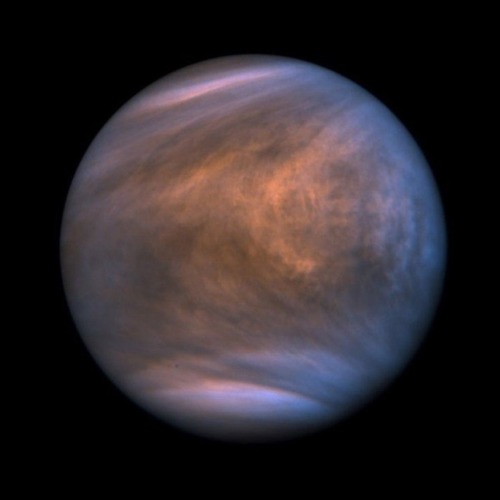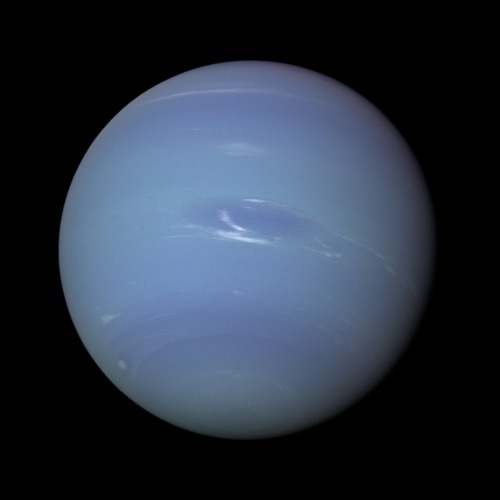RS Puppis, One Of The Brightest Cepheid Variable Stars © Hubble

RS Puppis, one of the brightest Cepheid variable stars © Hubble
More Posts from Of-finite-jurisdiction and Others
A Dusty Fingerprint in Space

A new image from NASA's James Webb Space Telescope reveals a remarkable cosmic sight: at least 17 concentric dust rings emanating from a pair of stars. Just 5,300 light-years from Earth, the star duo are collectively known as Wolf-Rayet 140. Each ring was created when the two stars came close together and their stellar winds (streams of gas they blow into space) collided so forcefully that some of the gas was compressed into dust. The stars' orbits bring them together about once every eight years, and forms a half-shell of dust that looks like a ring from our perspective. Like a cosmic fingerprint, the 17 rings reveal more than a century of stellar interactions—and the "fingerprint" belonging to Wolf-Rayet 140 may be equally unique. Other Wolf-Rayet stars produce dust, but no other pair are known to produce rings quite like Wolf-Rayet 140.
Learn more about Wolf-Rayet 140.
Make sure to follow us on Tumblr for your regular dose of space!


Neptune’s rings in infrared © JWST






Stephan’s Quintet/ Carina/ Southern Ring © JWST

Jupiter Rotates : Observe the graceful twirl of our Solar System’s largest planet. Many interesting features of Jupiter’s enigmatic atmosphere, including dark belts and light zones, can be followed in detail. A careful inspection will reveal that different cloud layers rotate at slightly different speeds. The famous Great Red Spot is not visible at first – but soon rotates into view. Other smaller storm systems occasionally appear. As large as Jupiter is, it rotates in only 10 hours. Our small Earth, by comparison, takes 24 hours to complete a spin cycle. The featured high-resolution time-lapse video was captured over five nights earlier this month by a mid-sized telescope on an apartment balcony in Paris, France. Since hydrogen and helium gas are colorless, and those elements compose most of Jupiter’s expansive atmosphere, what trace elements create the observed colors of Jupiter’s clouds remains a topic of research. via NASA
the new composite james webb image is so beautiful ive been staring at it for 10 minutes straight

featuring jupiters rings, europa (along with a bunch of other moons), the northern and southern auroras, and the great red spot
this is my space centered blog, sharing in case any of you guys like space too :^)

NGC 1365, Heart of the Galaxy


oh okay. heart steps right out of my chest and falls down the stairs



Venus, Callisto (Jupiter’s moon), Neptune
-
 tangledindream liked this · 7 months ago
tangledindream liked this · 7 months ago -
 saturn-of-the-monteleone reblogged this · 10 months ago
saturn-of-the-monteleone reblogged this · 10 months ago -
 mirzerker liked this · 1 year ago
mirzerker liked this · 1 year ago -
 tiny-feral-arachnid-man reblogged this · 1 year ago
tiny-feral-arachnid-man reblogged this · 1 year ago -
 marusyenka liked this · 1 year ago
marusyenka liked this · 1 year ago -
 atomicstarburstlabware reblogged this · 1 year ago
atomicstarburstlabware reblogged this · 1 year ago -
 fhyhtyh liked this · 1 year ago
fhyhtyh liked this · 1 year ago -
 atlas1701 liked this · 1 year ago
atlas1701 liked this · 1 year ago -
 fishyinspace liked this · 1 year ago
fishyinspace liked this · 1 year ago -
 joao1811 liked this · 1 year ago
joao1811 liked this · 1 year ago -
 thegodsofthepastareallgone reblogged this · 1 year ago
thegodsofthepastareallgone reblogged this · 1 year ago -
 jar-of-moondust reblogged this · 1 year ago
jar-of-moondust reblogged this · 1 year ago -
 jar-of-moondust liked this · 1 year ago
jar-of-moondust liked this · 1 year ago -
 kinasecrystal liked this · 1 year ago
kinasecrystal liked this · 1 year ago -
 schattengestalt liked this · 1 year ago
schattengestalt liked this · 1 year ago -
 brunheiffer liked this · 1 year ago
brunheiffer liked this · 1 year ago -
 thatisnotagoodswamp reblogged this · 1 year ago
thatisnotagoodswamp reblogged this · 1 year ago -
 wren-of-the-woods liked this · 1 year ago
wren-of-the-woods liked this · 1 year ago -
 enterprise-come-in reblogged this · 1 year ago
enterprise-come-in reblogged this · 1 year ago -
 wheresmybloodynauglamir liked this · 1 year ago
wheresmybloodynauglamir liked this · 1 year ago -
 hopecomesbacktolife reblogged this · 1 year ago
hopecomesbacktolife reblogged this · 1 year ago -
 hopecomesbacktolife liked this · 1 year ago
hopecomesbacktolife liked this · 1 year ago -
 tocautiouslygo liked this · 1 year ago
tocautiouslygo liked this · 1 year ago -
 undead-in-space liked this · 1 year ago
undead-in-space liked this · 1 year ago -
 honeyburn-blog liked this · 1 year ago
honeyburn-blog liked this · 1 year ago -
 greenroseunderglass liked this · 1 year ago
greenroseunderglass liked this · 1 year ago -
 asaemoryfanclub liked this · 1 year ago
asaemoryfanclub liked this · 1 year ago -
 starstr1ke liked this · 1 year ago
starstr1ke liked this · 1 year ago -
 dusty-brain liked this · 1 year ago
dusty-brain liked this · 1 year ago -
 lifebloodblue liked this · 1 year ago
lifebloodblue liked this · 1 year ago -
 catloverkid00 liked this · 1 year ago
catloverkid00 liked this · 1 year ago -
 vildo reblogged this · 1 year ago
vildo reblogged this · 1 year ago -
 vildo liked this · 1 year ago
vildo liked this · 1 year ago -
 sablackbeard liked this · 1 year ago
sablackbeard liked this · 1 year ago -
 holisticfansstuff reblogged this · 1 year ago
holisticfansstuff reblogged this · 1 year ago -
 holisticfansstuff liked this · 1 year ago
holisticfansstuff liked this · 1 year ago -
 imthecookiedunkedinmilk liked this · 1 year ago
imthecookiedunkedinmilk liked this · 1 year ago -
 neph-le-geek reblogged this · 1 year ago
neph-le-geek reblogged this · 1 year ago -
 linesofcode liked this · 2 years ago
linesofcode liked this · 2 years ago -
 matthew29992291799999920 liked this · 2 years ago
matthew29992291799999920 liked this · 2 years ago -
 anorecixs liked this · 2 years ago
anorecixs liked this · 2 years ago -
 frvncissca liked this · 2 years ago
frvncissca liked this · 2 years ago -
 tragenderproxy liked this · 2 years ago
tragenderproxy liked this · 2 years ago -
 aidragon liked this · 2 years ago
aidragon liked this · 2 years ago

Finn OFJ’s space blog. Do you love space?? you better. or else
39 posts